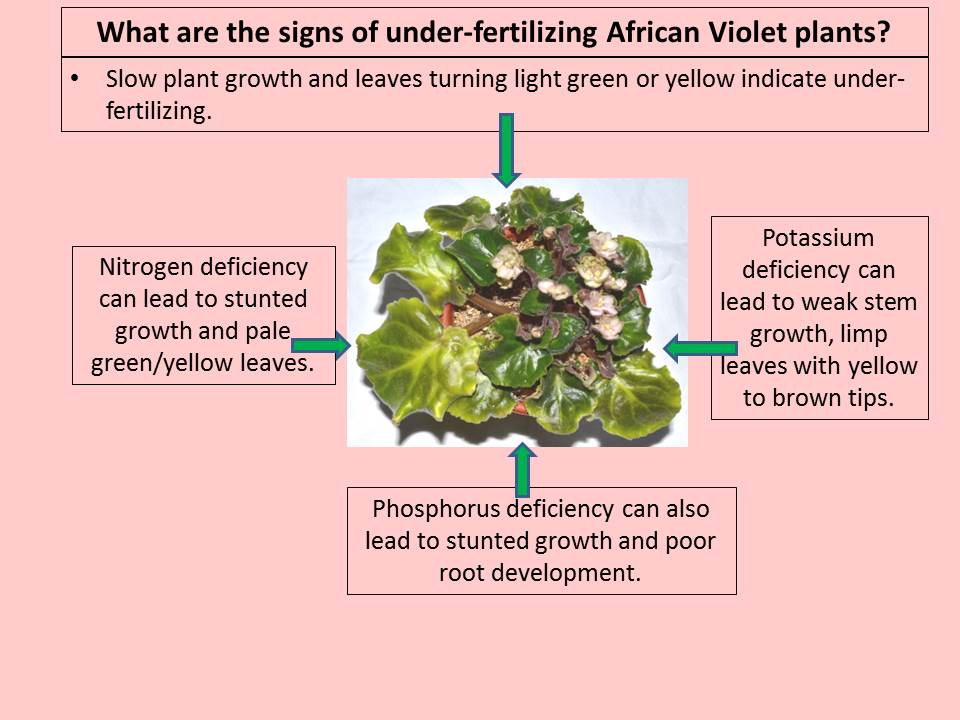Menu
Fertilizer for African Violet Plants
Here, we will only talk about fertilizer requirements for an African violet plant growing as a houseplant and not those growing for show (as show plants require fertilizer during exact timed intervals and in different amounts).

Major components of fertilizer:

- The plants do require other secondary and micro nutrients in smaller quantities such as sulfur, calcium, magnesium, boron, cobalt, iron, manganese, molybdenum and zinc.
- These are equally important to maintaining healthy plant growth.
Examples of commercially available African Violet fertilizers below:
Which commercial fertilizer to use for African Violet plants?

- I personally use a balanced fertilizer year round and do not change the composition. I would recommend optimara fertilizer (https://amzn.to/3oXUvCB).
- However, some do recommend changing the fertilizer ratio to induce blooms or variegation or if the plants are baby plants or if you are growing minis.
- Others recommend changing fertilizer ratios/brands once a year so that the plants are not bored with the same fertilizer.
- If you do change or rotate fertilizers, I would recommend trying out the new brand only on a few plants first.
How to apply / feed African Violet plants with fertilizer and how often?


Foliar Feeding African Violet Plants:
- Foliar feeding involves gently spraying the African Violet leaves with a diluted mixture of plant fertilizer.
- For more information on how to foliar feed African Violet plants, can visit blog post, “Foliar Feeding African Violet Plants“.
What are the signs of over-fertilizing African Violet plants?
- On the rim of the pots a crusty white salt like texture will develop, this indicates excess fertilizer salts. Repot the plant if it hasn’t been re-potted in the past year and clean the old pot. Then water with lukewarm plain water for the next 2 weeks before returning to routine fertilizing.
- The leaves may develop dark brown spots on the leaf center or tips.
- Leaves develop an orange colored crystallization clinging to the leaf hairs, especially in the plant crown area.
- Leaves start to wilt, turn brittle and develop cracks or lesions which turn brown.
- If you see these signs, first remove the damaged leaves, add lukewarm plain water to the soil, remove/clean the crystallization off of the leaves. Then continue to water with plain water for the next 3 weeks before applying fertilizer.
What are the signs of under-fertilizing African Violet plants?

Safety points to remember while fertilizing African Violet plants:
- Wear gloves while working with fertilizers. Dispose the gloves immediately (if they are disposable ones) or keep them in a sealed bag/container for later use.
- Store fertilizer powders /liquids in a cool, dry and dark area away from pets and children.
- Keep the outside of fertilizer containers clean. Wipe away any residue fertilizer.
- Try to make up only the amount of fertilizer water you are going to use, keep extra for later use, DO NOT throw/drain this chemical water down the sink or in the sewage system.
- Use a designated watering container for adding fertilizer, do not use this for other household purposes, and keep it separate only for adding fertilizer to plants.
Below are some items which can be useful while fertilizing & growing African Violet plants:

*Our Affiliate Programs: We are a participant in the Amazon Services LLC Associates Program, an affiliate advertising program designed to provide a means for us to earn fees by linking to Amazon.com and affiliated sites.
Though we do link to many items on Amazon out of convenience to our readers, we do also participate in other affiliate programs that also pay us a commission for any purchases you might make through our links (at no additional cost to you!).
Like this article?
Share on Facebook
Share on Twitter
Share on Linkdin
Share on Pinterest


21 Responses
This is by far the best African Violet site I have found. So much valuable information.
Thank you so much, really appreciate it! Any feedback/recommendations appreciated.
how to tell the differents between a male and female africian voilet
African Violet plants themselves do not have a gender. They have both male and female parts on the flowers. For example, the top of the pistil contains the stigma (sticky glistening part) which is the female part of the flower and the stamen contains the anthers with pollen sacs are the male parts of the flowers. Hope this helps.
Valuable information!
Thank you Elaine, appreciate it!
Thank you for this information. It is clear and easy to follow. I started growing AV last fall. Thankfully, I have been doing what you recommend. However, I have not had any blooms yet. Do they bloom seasonally? Thanks again
(Canada)
Hello Linda,
thanks for your message. African Violets usually bloom year round and not seasonally. There may be many reasons for African Violet plants not to flower. Did you change your soil recently. Are you regularly fertilizing your plant. Is there enough humidity in the room? Please check all these and make sure your plant hasnt gone through any external changes in a while. For me what worked best, was changing my watering method to wick watering. Suddenly all of my plants started forming buds. Though I should note, I first changed the soil in my plants, put the wicks in, then after a month, I fertilized them and then I saw buds and after that they have continuously flowered. Hope this helps, BV
I have just replanted two violets in pots with wick watering, as per your instructions. How do I fertilize them?
Hello Ivana,
thank you for your question. In the same article about wicking, if you scroll down to the bottom there is a detailed section labelled, “How to add fertilizer to water- wicked African Violet plants?”, it gives information about fertilizing wicked African Violet plants. Also can read the general article about fertilizing African Violet plants at
https://www.babyviolets.com/fertilizer-for-african-violet-plants/.
Hope this helps,
BV
Hi. My sister and I are having a huge problem with tiny crowded crowns. We stopped buying commercial soil and now do our own with peat moss and perlite.
We also cut back on the fertilizer.
Will the plants ever come back to normal?
Petra.
Hello Petra,
Thank you for your question. Tiny crowns, have been a common problem lately. Good to hear you make your own mix, thats the best way, you have more control. After any changes are made to the plants environment (new soil, fertilizer change, light etc….), it takes about 2-3 weeks for the plant to show a change in culture. You will have to wait a minimum of 2 weeks to see if it made a difference. Its usually a trial an error. Change one thing at a time and you can pin point what helped the most. Yes, tight crowns can be reversed, if its due to too much fertilizer or light. If its mites, no that cannot be reversed, especially severe, tight crowns with brittle leaves. I would toss that plant. Unless if its rare or sentimental, then you can use a miticide. Hope this helps, regards, BV
Awesome site, best yet I’ve seen. Thanks.
The image at the top of this page shows Nitrogen content lower than the other two, yet all the advertised ones have higher Nitrogen content???
Thank you Everett, glad you found the site useful. The fertilizer values are displayed as N-P-K, Nitrogen-Phosphorus-Potassium. Yes nitrogen should be low, as the image shows. The advertised ones, all have low nitrogen, which is the first value (number). The middle value (number) is phosphorus, which is the one higher and it varies between manufacturers. Hope this helps, regards, BV
Hello. I am struggling with just how much fertilizer to give just a single plant and I think I may have been over fertilizing. The directions call for 1 dose (which is pre-measured, Espoma Easy Dose, 7ml) to be added to a quart of water. Once that is done, how how much of that mixture do I give to my violet?? And once I make the mixture can I keep it? Or maybe I should try something else? Thank you.
Hello Rebecca,
I am not sure about the espoma easy dose, havent used before. I would recommend to use the dose labelled on the package. Once mixed, you should give enough to moistened the soil or until you see water drain out from the bottom of the pot holes. I use 1/4tsp of powdered balanced fertilizer in a gallon of water. Sometimes, I will half that (1/8th tsp in half a gallon) if I have fewer plants. Yes, you can store your fertilizer water, that shouldn’t be a problem. I would recommend the optimara fertilizer, https://amzn.to/3oXUvCB, it has given great results for me. Hope this helps, BV
My AV had grown to the side of my wick watering plastic container and the roots are on top of the plant. What is causing this ?
Hello Donna,
thank you for your question. Seems like your plant is due for a re-potting. Maybe the rootball has grown quite large and there is no space for the roots to spread within the soil. You can gently lift out your African Violet from the pot and check its root growth. You can re-pot to a one pot larger size and re-position your Violet in the center of the pot, also can cut some roots from the bottom if they are long and twisted. About the plants growing to the side, have you been rotating the Violet so it receives equal sunlight on each side. You can rotate the plant once every 2 weeks, so that it doesnt grow towards one side or lopsided. Hope this helps, regards BV